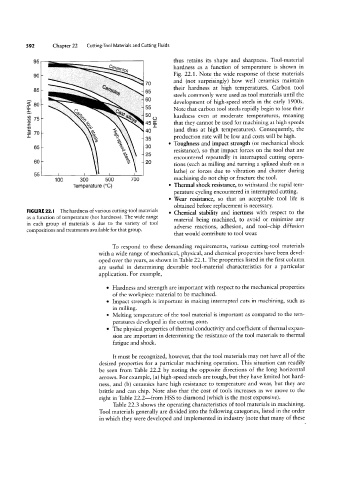Page 611 - 04. Subyek Engineering Materials - Manufacturing, Engineering and Technology SI 6th Edition - Serope Kalpakjian, Stephen Schmid (2009)
P. 611
592 Chapter 22 Cutting-Tool Materials and Cutting Fluids
95 thus retains its shape and sharpness. Tool-material
Ceramics hardness as a function of temperature is shown in
90 - Fig. 22.1. Note the wide response of these materials
_ 70 and (not surprisingly) how well ceramics maintain
85 _ Céfbfbla 65 their hardness at high temperatures. Carbon tool
A 8 60 steels commonly were used as tool. materials until the
E 80 _ development of high-speed steels in the early 1900s.
E QQ Ca ' 55 Note that carbon tool steels rapidly begin to lose their
3 75 _ 'QQ WS;/oy ‘ 50 O hardness even at moderate temperatures, meaning
2 /bo ‘S` 45 § that they cannot be used for machining at high speeds
§ 70 _ Q, ‘§ 40 (and thus at high temperatures). Consequently, the
12,
I _ 35 production rate will be low and costs will be high.
65 _ in ‘Egg _ 30 ° Toughness and impact strength (or mechanical shock
Q) _ 25 resistance), so that impact forces on the tool that are
Ԥ encountered repeatedly in interrupted cutting opera-
60 _
“° _ 20 tions (such as milling and turning a splined shaft on a
55 lathe) or forces due to vibration and chatter during
100 300 500 700 machining do not chip or fracture the tool.
Temperature (°C) Thermal shock resistance, to withstand the rapid tem-
perature cycling encountered in interrupted cutting.
Wear resistance, so that an acceptable tool life is
obtained before replacement is necessary.
FIGURE 22.1 The hardness of various cutting-tool materials Chemical stability and inertness with respect to the
as a function of temperature (hot hardness). The wide range material being machined, to avoid or minimize any
in each group of materials is due to the variety of tool adverse reactions, adhesion, and tool-chip diffusion
compositions and treatments available for that group.
that would contribute to tool wear.
To respond to these demanding requirements, various cutting-tool materials
with a wide range of mechanical, physical, and chemical properties have been devel-
oped over the years, as shown in Table 22.1. The properties listed in the first column
are useful in determining desirable tool-material characteristics for a particular
application. For example,
° Hardness and strength are important with respect to the mechanical properties
of the workpiece material to be machined.
° Impact strength is important in making interrupted cuts in machining, such as
in milling.
° Melting temperature of the tool material is important as compared to the tem-
peratures developed in the cutting zone.
° The physical properties of thermal conductivity and coefficient of thermal expan-
sion are important in determining the resistance of the tool materials to thermal
fatigue and shock.
It must be recognized, however, that the tool materials may not have all of the
desired properties for a particular machining operation. This situation can readily
be seen from Table 22.2 by noting the opposite directions of the long horizontal
arrows. For example, (a) high-speed steels are tough, but they have limited hot hard-
ness, and lb) ceramics have high resistance to temperature and wear, but they are
brittle and can chip. Note also that the cost of tools increases as we move to the
right in Table 22.2-from HSS to diamond (which is the most expensive).
Table 22.3 shows the operating characteristics of tool materials in machining.
Tool materials generally are divided into the following categories, listed in the order
in which they were developed and implemented in industry (note that many of these

